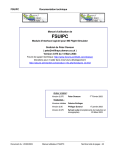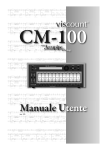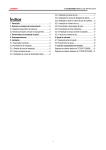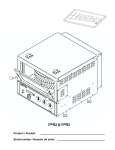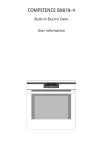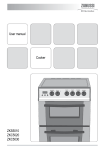Download Electrolux EOC 69400 User's Manual
Transcript
user manual Oven EOC 69400 2 electrolux Electrolux. Thinking of you. Share more of our thinking at www.electrolux.com Contents Safety tips Description of the appliance The electronic oven controls Operation Tips, tables and advice Care and maintenance 2 3 6 9 16 29 What to do if… Disposal Installation European Guarantee Consumer services 34 35 35 38 40 Subject to change without notice Safety tips Electrical safety • This appliance must only be connected by a qualified electrician. • In the event of a fault or damage to the appliance: Take the fuses out or switch the appliance off. • Repairs to the appliance must only be carried out by qualified service engineers. Considerable danger may result from improper repairs. If repairs become necessary, please contact our Customer Care Department or your dealer. Children's safety • Never leave small children unattended while the appliance is in operation. • To protect against unauthorised use the appliance is equipped with a switch-on lock. Safety during use • Persons (including children) who, due to their physical, sensory or mental capacity or their inexperience or lack of knowledge are unable to use the appliance safely should not operate this appliance without the supervision or instruction of a responsible person. • This appliance should be used only for normal domestic cooking, roasting and baking of food. • Be careful if connecting electrical appliances to sockets near to this appliance. Electrical leads must not be caught under the hot oven door. Warning! WARNING: Risk of burns! The oven interior becomes hot when in use. • If you use ingredients containing alcohol in the oven, a slightly flammable mixture of alcohol and air may ensue. In this case, be careful when opening the door. Do not handle any sources of heat, sparks or naked flames when doing so. Information on acrylamides According to the latest scientific knowledge, intensive browning of food, especially in products containing starch, can constitute a health risk due to acrylamides. Therefore we recommend cooking where possible at low temperatures and not browning foods too much. How to avoid damage to the appliance • Do not line the oven with aluminium foil and do not place baking trays, pots, etc. on the oven floor, as the heat that builds up will damage the oven enamel. • Fruit juices dripping from the baking tray will leave stains, which you will not be able to remove. For very moist cakes, use a deep tray. • Do not put any strain on the oven door when open. • Never pour water directly into the oven when it is hot. This could cause damage to and discoloration of the enamel. • Rough handling, especially around the edges of the front panel, can cause the glass to break. • Do not store any flammable materials inside the oven. These could ignite when the oven is switched on. electrolux 3 • Do not store any moist foods inside the oven. These could damage the oven enamel. • Do not leave dishes uncovered in the oven after switching off the cooling fan. Moisture may form inside the oven or on the glass door and also get onto the units. affect the oven's suitability for normal and correct use. They therefore do not constitute a defect in terms of warranty law. Note: Enamel coating Changes in the colour of the oven's enamel surface as a result of use do not Description of the appliance General view 3 1 2 1 Operating panel 2 Oven door 3 Light bar If no function has been selected and nothing has been changed on the appliance, after 2 minutes the appliance 4 electrolux switches itself off but the light bar remains on. To switch the light bar off, switch the appliance on and off again. Operating panel Overview 2 1 3 1 ON/OFF-Button, to switch on, press and hold 2 Display 3 Selector with OK key for selecting a menu option 4 Additional Functions key 5 Sensor keys for selecting a cooking category 4 5 If the oven has been switched off, the time of day is shown. If the oven is still hot, a bar appears in the display and shows the residual heat remaining in the oven. When the oven is switched on, the display shows the menu and information about the oven's operating status. Display The information shown in the display varies according to the oven's operating status. Symbols Minute Minder Time of Day Duration End Time Running Time Oven Temperature Calculation Rapid Heat Up Temperature Display electrolux 5 Oven layout 1 2 3 4 5 6 7 8 9 10 11 Top heat and grill element Oven light bulb Meat probe socket Grease filter Oven light bulb Ring heating element, fan Bottom Heat Side rails, removable Oven levels Rotary spit drive mechanism Smell filter Oven accessories 11 10 9 1 2 5 3 4 5 6 7 4 3 2 1 8 Meat probe Tray For cakes, biscuits and pastry. For determining exactly how well done pieces of meat are during cooking. Meat/Drip pan Rotary spit with support For baking and roasting or for use as a tray to catch grease. For roasting larger pieces of meat and poultry. 6 electrolux Shelf For cookware, cake tins, roasts and for grilling food. The electronic oven controls Menus and operation You use the menu to operate the oven. The Main Menu contains: Main Menu Auto Cooking Heating Functions Cleaning Menu Basic Settings Specials Selecting the menu options • Turn the Selector in a clockwise direction to get to the next function. • Turn the Selector anticlockwise to get to the previous menu function. Opening the Main Menu To call up the Main Menu, press the On/Off key. If set to the factory settings, the "Auto Cooking" function is selected. Opening "Auto Cooking" Menu 1. Press the sensor key for the desired category. 2. Use the Selector to select the desired dish or the subcategory. 3. Follow the instructions in the display. Selecting a menu option in the menu 1. Use the Selector to select the desired menu option. 2. When the desired menu option is shown in the display, press the OK key to call it up. Use "Back" at the end of each menu to get back to the previous menu. Auto Cooking General The "Auto Cooking" menu is divided into five categories. These can be used to select the optimum setting for a variety of dishes. Press the relevant sensor key. The categories are divided into various subcategories and dishes, which are then programmed with the appropriate settings. You can find an overview of all the categories and dishes in the "Auto Cooking" menu in the accompanying Quick User's Guide. Assistance as to how the dishes have been classified into the various categories can be found in the accompanying Cooking and Baking Overview. Symbol Category Baking electrolux 7 Symbol Category Roasting Convenience food Oven dishes Pizza Operating principle When using "Auto Cooking" the oven calculates the required cooking time. Unlike standard ovens, you do not need to set a type of heat or cooking time. Instead, you simply select the desired food type from the category menu. "Auto Cooking" is only possible on one oven level. Only use the grease filter when roasting. Otherwise, the oven is unable to calculate the optimum times. To attain optimum results, you should use the recommended cookware and/or accessories. You can find further information in the section "Tips, Tables and Advice". Heating Functions For manually setting Heating Functions and cooking temperature. Heating Functions Fan Cooking For baking on up to three levels simultaneously. Set the oven temperatures 20 – 40° lower than for Conventional Cooking Conventional Cooking For baking and roasting on one level Pizza Setting For baking on one level for dishes that require intensive browning and a crispy base. Set the oven temperatures 20 – 40° lower than for Conventional Cooking Turbo Grill For roasting larger pieces of meat or poultry on one level. Also suitable for gratins and browning. Turbo Grill + Spit Roast Economy Grill For grilling flat foods which are placed in the middle of the rack and for toasting. Economy Grill + Spit Roast For grilling a chicken or small rolled roasts Dual Grill For grilling flat foods in large quantities and for toasting. Dual Grill + Spit Roast For grilling two chickens or one rolled roast Bottom Heat For baking cakes with crispy or crusty bases. Slow Cook For preparing particularly tender, succulent roasts 8 electrolux Specials For selecting additional heating functions Specials Defrost Drying Keep Warm Preserving Plate Warming Basic Settings For changing various " Basic Settings " of the oven. Basic Settings Set time of day Sets current time on the clock Time Indication When on, the time of day is displayed when the oven is switched off When off, the display switches itself off completely Contrast Adjusts the display Display Brightness Adjusts the display Set Language Buzzer Volume Key Tones Switches key tones on or off Alarm/Error Tones Switches alarm/error tones on or off Smell Filter Smell Filter activate or deactivate Calibration Adapts oven to the kitchen environment, e.g. after moving house Service Indicates the version of the software, the configuration and the period of operation Factory Settings Resets all basic settings to the original factory settings Cleaning Menu Pyrolytic cleaning and other functions. Cleaning Menu Pyrolytic To clean the oven using pyrolytic cleaning Cleaning Assistant Reminds you of various points that should be noted prior to pyrolytic cleaning. Can be switched on or off. Cleaning Reminder Recognises when pyrolytic cleaning is required and alerts the user to this fact. Can be switched on or off. electrolux 9 Additional Functions You can use the Additional Functions key to set the available Additional Functions. Additional Functions menu Minute Minder KEY LOCK Duration/End Time Meatprobe Operation Prior to first use Before using the oven, first of all the language, then the contrast of the display, the brightness and the current time of day must be set. When you switch on the oven for the first time, "SET LANGUAGE" appears in the display after a few seconds. 1. Use the Selector to select the desired setting 2. Then press the OK key to confirm your setting. Make the additional basic settings required in the same way. Adapting oven to the kitchen environment For optimum results using "Auto Cooking" the oven must be adjusted to suit the environment. This procedure is called Calibration and takes approximately 4 hours. If you only want to use the oven for manual cooking, it does not need to be calibrated. Please take note of the following points prior to Calibration • Calibration must take place at a room temperature below 35°C. • For Calibration, the oven must be installed in its final location. • For Calibration, connect the oven to the mains supply and do not disconnect it again. • Be sure to remove the grease filter prior to Calibration. • If the installation location, electrical connection or one of the other points listed above is changed, the oven must always be recalibrated so that the "Auto Cooking" function delivers optimum results. You will find the calibration in the "Basic Settings", "Calibration" menu. Following calibration, the appliance is ready to be used, as soon as it has cooled down. Initial cleaning The oven should be thoroughly cleaned prior to first use. Wipe all parts and the interior with a solution of water and washing-up liquid. Important! Do not use any sharp or abrasive cleaning materials. These could damage the surface. Switching on and off – Press the ON/OFF button. If the oven has been switched off, the time of day is shown. If the oven is still hot, a bar appears in the display and shows the residual heat remaining in the oven. Auto Cooking 1. Switch the oven on. 2. Press the key for the desired category. – The available dishes or subcategories will be shown. 3. Select the desired category or the dish directly. 4. Follow the instructions on the display. Example: Frozen Pizza Calzone 1. Switch the oven on. 2. Press the Pizza button. 10 electrolux – Four different types of pizza are shown. 3. Use Selector to select "Frozen Pizza". 4. Then press the OK key to call up the subcategory. – Three different types of frozen pizza can be selected from. 5. Use the Selector to select "Calzone". 6. Then press the OK key to call up this dish. 7. Follow the instructions on the display. After the set time has expired, the heating function with the set temperature can be extended by 20 minutes within the next 5 minutes, if the baking result is not yet satisfactory. Manual baking and roasting It is possible to change the oven function or the temperature while the manual baking and roasting is in operation. For more information see the next paragraph. 1. Switch the oven on. 2. Use the Selector and then the OK key to select "Heating Functions". – The heating functions will be shown. 3. Select the desired function. – A suggested temperature is indicated in the display. 4. Change the temperature using the Selector, if you wish. 5. Then press the OK key to confirm the oven temperature. 6. Press the Additional Functions key. – The cooking time will show in the display. 7. Turn the Selector to set the cooking time. 8. Then press the OK key to confirm the cooking time. – The display for the end time will flash. 9. Turn the Selector to set the end time. 10. Then press the OK key to confirm the end time. – The oven will begin to heat or will automatically turn itself on and off at the desired time. After the set time has expired, the heating function with the set temperature can be extended by 20 minutes within the next 5 minutes, if the baking result is not yet satisfactory. Changing the temperature while the 'manual baking and roasting' is running 1. To change the temperature after starting the oven, turn the selector to the right. 2. The frame will mark the right part of the display (where present temperature is displayed). Press the OK key to make the selection. 3. The triangle next to the present temperature will start blinking. Than using the selector choose the desired new temperature. 4. Accept the new temperature with the OK key. Changing the oven functions while the 'manual baking and roasting' is running 1. To change the oven function after the oven has started turn the selector to the left. 2. The frame will mark the left part of the display (where current oven function is displayed). Press OK key to make the selection. 3. Choose the desired new oven function. 4. Accept the new oven function with the OK key. Meatprobe When using the Meatprobe the oven automatically turns itself off when the desired core temperature has been reached. electrolux 11 Important! Important: Only the Meatprobe supplied may be used. If replacing, please use only genuine replacement parts Using the meatprobe 1. Switch on the oven. 2. Place the meat probe in the meat. The tip of the Meatprobe must be in the middle of the piece of meat. 2 Changing the core temperature at a later time – Repeatedly press the Additional Functions key until the set core temperature appears in the display. – If necessary, change the temperature using Selector. Setting the Minute Minder You can set an alarm using the " Minute Minder " function. 1. Repeatedly press the Additional Functions key until "Minute Minder" appears in the display. 00:00:00 Minute Minder 1 1/1 2. Turn the Selector to set the desired alarm time. 3. Then press the OK key and the time will count down. 3. Insert the plug of the Meatprobe as far as it will go into the socket on the side wall of the oven. – A suggestion for the core temperature will show in the display. 600C Meatprobe 1/2 4. Using the Selector, set the desired core temperature. 5. Then press the OK key to confirm the temperature. 6. Set the heating function and the desired oven temperature. The core temperature is displayed from 30° Within a few minutes, a provisional end time is calculated, at which the core temperature set will be reached. This time is constantly recalculated and updated in the display. The system requires that the Meatprobe is pushed into the meat and into the socket at the beginning of the cooking process and that it is not removed during the cooking process. Press the OK key to switch off the alarm. KEY LOCK You can switch the KEY LOCK on and off using the Additional Functions key. The activated KEY LOCK prevents unintentional changing of settings. 1. Repeatedly press the Additional Functions key until "KEY LOCK" appears in the display. 2. Follow the instructions on the display. Switch-on Lock The appliance can be locked using the "Switch-on Lock" function. This can prevent e.g. children switching on the appliance when they shouldn't. Switching the switch-on lock on/off (no function must be selected) • Simultaneously press "Baking" and "Pizza" until a signal sounds. When the appliance is locked, "Appliance locked." appears in the display Mechanical door lock When the appliance is delivered, the door lock is deactivated. 12 electrolux Activating the door lock B 1. Take hold of the door trim (B) on the upper edge of the door at both sides and press inwards to release the clip seal. Then remove the door trim by pulling it upwards. Important! There is a guide bar (C) on the open side of the door trim (B). This must be pushed between the outer door panel and the guide corner (D). The clip seal (E) must be snapped in. B C D E 2. Activate lever: Remove lever (1), move it 4 mm to the left (2) and re-insert (3). 2 1 3 To open the oven door. 3. Take hold of the door trim (B) at each side, position it on the inside edge of the door and plug the door trim (B) into the upper edge of the door. 1. Keep lever pressed. electrolux 13 2. Open the door. To close the oven door Close door without pressing the lever. To deactivate door lock To deactivate the door lock, the lever is moved to the right again. Proceed as described above. Important! Switching off the appliance does not remove the mechanical door lock. Removing door lock 3 2 4. Take hold of the door trim (B) at each side, position it on the inside edge of the door and plug the door trim (B) into the upper edge of the door. B 1. Take hold of the door trim (B) on the upper edge of the door at both sides and press inwards to release the clip seal. Then remove the door trim by pulling it upwards. B 2. Demount lever: Remove lever (1). 1 3. Remove trim from the under side of the door trim (B)(2) and push in (3). 14 electrolux Important! There is a guide bar (C) on the open side of the door trim (B). This must be pushed between the outer door panel and the guide corner (D). The clip seal (E) must be snapped in. C D E 5. Close the oven door. Starting up after an Automatic switchoff Press the OK key on the Selector Smell Filter The Smell Filter is activated in the "Basic Settings" menu. If the Smell Filter is switched on, it will start automatically during baking and roasting. The filter is deactivated when the appliance is set to the factory settings. If the Smell Filter is switched on, the oven uses more energy. Even if the Smell Filter is switched off, it will switch on after every 100 hours of operation during baking or roasting in order to clean itself. The Smell Filter operates during pyrolytic cleaning of the oven, even if it is switched off at the time of cleaning. 1. Select "Basic Settings" from the Main menu. 2. Then press the OK key to call up this menu. 3. Use the Selector to select "Smell Filter". 4. Then press the OK key to make the changes. 5. Use the Selector to activate (ON) or deactivate (OFF) the filter. 6. Press the OK key to confirm the setting. The setting is changed. Inserting the shelf, tray and roasting tray Auto switch-off of the oven If the oven is not switched off after a certain time, or if the temperature is not modified, it automatically switches itself off. The oven automatically switches itself off when the oven temperature is: • 30 -120°C after 12.5 hours • 120 -200°C after 8.5 hours • 200 -250°C after 5.5 hours • 250 - max°C after 3.0 hours To increase shelf runner safety, all insertable components have a small curved indentation on the right and lefthand edge. Always insert insertable components so that this indentation is at the back of the oven interior. This indentation is also important for preventing the insertable components from tipping. Push the tray or roasting tray Push the tray or roasting tray between the guide bars of the selected oven level. electrolux 15 Inserting the oven shelf: Insert the oven shelf so that the feet point downwards. Push the oven shelf between the guide bars of the selected oven level. The high rim around the oven shelf is an additional device to prevent cookware from slipping off. Inserting the oven shelf and roasting tray together: Place the shelf on the roasting tray. Slide the roasting tray between the guide bars of the selected oven level. Inserting/Removing the grease filter Only insert the grease filter when roasting in order to protect the rear wall heating element from spitting fat. Inserting the grease filter Hold the grease filter by the tab and insert the two mounts downwards into the opening on the rear wall of the oven (fan opening). Remove the grease filter Hold the grease filter by the tab, unhook it and lift out. 16 electrolux Rotary spit Attaching the food to be grilled 3. Attach the handle and press the clip down. 4. 5. 6. 7. The clip must remain depressed to ensure that the handle fits securely on the rotary spit. Press the end of the spit into the drive socket on the left-hand side of the rear wall. Place the groove in front of the handle in the notch in the rotary spit support provided for this purpose. Remove the handle. Set the heating function and desired temperature in accordance with the instructions provided in the Rotary Spit Table. 1. Place the fork on the rotary spit. 2. Slide the item to be grilled and the second fork onto the spit. 5 Centre the item to be grilled, so that it is in the middle. 3. Tighten the forks. 3 Inserting the rotary spit 1 Ensure that the rotary spit is turning. Removing the rotary spit Use the handle to remove the spit. The rotary spit is very hot at the end of the cooking process. Warning! There is a risk of burning when removing the spit! Switch off the appliance 1. Insert the roasting tray into the lowest oven level. 2. Insert the rotary spit support into the 5th level from the bottom at the front righthand side. Tips, tables and advice Auto Cooking To attain optimum results, you should use the recommended cookware or accessories. Important! Ensure that cookware made of plastic or with plastic handles is heatresistant! electrolux 17 Baking, Home Baking Sponge Cake Type - Ovenware Spring form Accessories Shelf Flat sponges, Swiss roll Notes Batter with no or very little fat content conventional Yeast Plait Type - Ovenware - Accessories Tray Notes 1 piece Cake Tray Type - Ovenware - Accessories Tray Notes Tray completely filled, no roasting tray Cake Tin Type - Ovenware cake tin Accessories Shelf Shortcrust bases Notes Various types of cake which are baked in tins. conventional Tarte Type Ovenware Tart tin Spring form Accessories Shelf Notes Cakes with minimal topping, e.g. jam Pie/Quiche Type - Ovenware Quiche tin Spring form Tart tin Accessories Notes Shelf Strudel Type - Ovenware - Accessories Tray Notes 1 piece Fruit Cake Type - Ovenware Square tin Spring form Accessories Shelf Notes with dried fruit Pastry Type Ovenware Accessories Notes Sweet - Tray multiple pieces Salty - Tray multiple pieces Important! Bake cookies and biscuits the traditional way! 18 electrolux Bread Type Ovenware Accessories Notes Tin Bread tin Shelf 1 tin Tray - Tray 1 tin Flat Bread - Tray 1 or 2 pieces (e.g. baguettes) Rolls Type Ovenware Accessories Notes Savoury - Tray multiple small pieces Sweet - Tray multiple small pieces, e.g. sweet yeast rolls Cake Special Type Victoria Sponge Cake Ovenware - Accessories - Notes English speciality Roasting Always insert the grease filter when roasting in order to minimise soiling of the oven. Beef/Lamb/Game Type Ovenware Accessories Notes Top Side Beef Roasting tin Meatprobe, Drip pan Select the desired degree of cooking (Rare, Medium or Well-done) Scandinavian Beef Roasting tin Meatprobe, Drip pan Select the desired degree of cooking (Rare, Medium or Well-done) Roast Beef Roasting tin Drip pan Set the weight Lamb Joint, medium Roasting tin Meatprobe, Drip pan - Roast Lamb Roasting tin Drip pan Set the weight Loin of game Roasting tin Meatprobe, Drip pan - Roast Game Roasting tin Drip pan Set the weight Poultry/Fish Type Ovenware Accessories Notes Boned Poultry Roasting tin Meatprobe, Drippan - Chicken, whole Roasting tin Drip pan Set the weight Turkey, whole Roasting tin Drip pan Set the weight Duck, whole Roasting tin Drip pan Set the weight Goose, whole Roasting tin Drip pan Set the weight Whole Fish Roasting tin Meatprobe, Drippan - Pork/Veal Type Ovenware Accessories Notes Loin of pork Roasting tin Meatprobe, Drippan - Roast Pork Roasting tin Drip pan Set the weight electrolux 19 Type Ovenware Accessories Notes Back of Veal Roasting tin Meatprobe, Drippan - Roast Veal Roasting tin Drip pan Set the weight Convenience food Frozen Potato Types Type - Ovenware - Accessories Tray Notes Various potato convenience foods, chips, wedges, croquettes... Frozen Pastry Type Ovenware Accessories Notes Sweet - Tray multiple small pieces Salty - Tray multiple small pieces Fresh Pastry Type Ovenware Accessories Notes Sweet - Tray multiple small pieces Salty - Tray multiple small pieces Rolls/Baguette Type Ovenware Accessories Notes Frozen - Tray multiple small pieces Not frozen - Tray - Frozen Fish/Meat Type Ovenware Accessories Notes Fish au Gratin Heat-resistant dish Shelf - Breaded Fish/Meat - Tray multiple small pieces, e.g. fish fingers, cordon bleu Frozen Pie/Quiche Type - Ovenware - Accessories Tray Notes - Potato Dishes Type Ovenware Accessories Notes Frozen Heat-resistant dish Shelf - Fresh Heat-resistant dish Shelf - Pasta Dishes Type Ovenware Accessories Notes Frozen Heat-resistant dish Shelf - Fresh Heat-resistant dish Shelf - Rice Dishes Type Frozen Ovenware Heat-resistant dish Accessories Shelf Notes pre-cooked rice 20 electrolux Type Fresh Ovenware Heat-resistant dish Accessories Shelf Notes pre-cooked rice Vegetable Dishes Type Ovenware Accessories Notes Frozen Heat-resistant dish Shelf - Fresh Heat-resistant dish Shelf - Frozen Strudel Type - Ovenware - Accessories Tray Notes 1 or 2 pieces Snack Type - Ovenware - Accessories Tray Notes multiple small pieces Oven dishes, home-made Meat/Fish Casserole Type Ovenware Accessories Notes High Casserole Heat-resistant dish Shelf > 4 cm Flat Casserole Heat-resistant dish Shelf < 4 cm Potato Dishes Type - Ovenware Heat-resistant dish Accessories Shelf Notes - Pasta Dishes Type - Ovenware Heat-resistant dish Accessories Shelf Notes Sprinkle with Parmesan cheese towards the end of the baking time Vegetable Dishes Type - Ovenware Heat-resistant dish Accessories Shelf Notes - Rice Dishes Type - Ovenware Heat-resistant dish Accessories Shelf Notes pre-cooked rice Sweet Dishes Type - Ovenware Heat-resistant dish Accessories Shelf Notes - Soufflé Type Ovenware Accessories Notes One large tin Heat-resistant dish Shelf - Small Tins In small tins Shelf multiple tins electrolux 21 Au Gratin Type - Ovenware Heat-resistant dish Accessories Shelf Notes Sprinkle with Parmesan cheese towards the end of the baking time. Pizza Fresh Pizza Type Ovenware Accessories Notes Thick - Tray Thick crust, lots of topping (American style) Thin - Tray Thin crust, little topping (Italian style) Calzone - Tray Frozen Pizza Type Ovenware Accessories Notes Parbaked - Tray Pizza base, partially baked, without additional topping Not parbaked - Tray without extra topping Calzone - Tray - Fresh Pizza parbaked Type - Ovenware - Accessories Tray Notes - Pizza Snack Type - Ovenware - Manual baking and roasting In case you wish to prepare meals with manual settings, the following tables and tips provide useful information. In the tables you will find a selection of dishes with the appropriate settings. Baking Oven levels • Baking with Conventional Cooking is only possible on one level. • When baking with Fan Cooking , one to three baking trays can be put into the oven at the same time: Accessories Tray Notes - 1 tray, e.g. oven level 3 1 cake in cake tin, e.g. oven level 1 22 electrolux This happens due to the large difference in temperature between the frozen item and the oven. After cooling, the buckling in the trays disappears. 2 tray, e.g. oven levels 1 and 3 3 trays, oven levels 1, 3 and 5 Baking tins • Baking tins made from dark-coloured metal with Teflon coating are suitable for baking using Conventional Cooking. • For baking using the Fan Cooking function, baking tins made of shiny light-coloured metal are suitable. • Baking tins of dark metal with antistick coating are inserted on grid. Baking tins of light metal are inserted on baking tray General instructions • Insert the tray with the bevel at the front. • When baking using Conventional Cooking and Fan Cooking, you can also place two baking trays next to one another on one level. This does not significantly affect the baking time. When frozen items are placed on baking trays, they can buckle during cooking. Baking Tables Baking in tins (on one level) Type of baking How to use the Baking Tables • The tables give the required temperature settings, cooking times and oven levels for a selection of typical dishes. • Temperatures and baking times are for guidance only, as these will depend on the consistency of pastry, dough or mixture, the amount and the type of baking tin. • We recommend setting the oven to a lower temperature for the first time and only setting a higher temperature when required, e.g. if you require more browning or if the baking is taking too long. • If you cannot find the settings for a certain recipe, look for similar items. • The baking time can be 10-15 minutes longer when baking cakes on trays or in tins on multiple levels. • Recipes with moist ingredients such as pizzas or fruit flans are to be baked on one level. • Cakes and pastries at different heights may brown at an uneven rate at first. You should not change the temperature setting if this occurs. Different rates of browning even out as baking progresses. • Baking and roasting times could differ from those of your previous oven. For this reason you should adjust the settings you usually use (temperature, cooking times, etc.) and oven levels to the recommendations provided in the following tables. Unless otherwise stated, the values given in the tables assume that cooking is started with the oven cold. Heating Function Level Temperature (°C) Time (h:min) Ring Cake or Brioche Fan Cooking 1 150 - 160 0:50 - 1:10 Madeira Cake/Fruit Cake Fan Cooking 1 150 - 160 1:10 - 1:30 Sponge Cake Fan Cooking 1 140 1:10 - 1:30 Sponge Cake Conventional Cooking 1 160 1:10 - 1:30 Flan base - shortcrust pastry 1) Fan Cooking 3 170-180 0:10 - 0:25 Flan base - sponge mixture Fan Cooking 3 150 - 170 0:20 - 0:25 electrolux 23 Type of baking Heating Function Level Temperature (°C) Time (h:min) Apple tart (covered) Conventional Cooking 1 170 - 190 0:50 - 1:00 Apple Pie (2 tins, Ø 20 cm, placed diagonally) Fan Cooking 1 160 1:10 - 1:30 Apple Pie (2 tins, Ø 20 cm, placed diagonally) Conventional Cooking 1 180 1:30 - 1:30 Savoury Flans (e.g. Quiche) Fan Cooking 1 160 - 180 0:30 - 1:10 Cheesecake Conventional Cooking 1 170 - 190 1:00 - 1:30 1) Pre-heat oven Cakes/pastries/breads on baking tray (one level) Type of baking Heating Function Level Temperature (°C) Time (h:min) Yeast Plait/Yeast Crown Conventional Cooking 3 170 - 190 0:30 - 0:40 Christmas Stollen 1) Conventional Cooking 3 160 - 180 0:30 - 0:40 Bread (rye bread) 1) -first of all -then Conventional Cooking 1 230 160 - 180 0:25 0:30 - 1:00 Cream puffs/éclairs 1) Conventional Cooking 3 160 - 170 0:15 - 0:30 Swiss roll 1) Conventional Cooking 3 180 - 200 0:10 - 0:20 Streusel Cake, dry Fan Cooking 3 150 - 160 0:20 - 0:40 Buttered Almond Cake/Sugar Cakes 1) Conventional Cooking 3 190 - 210 0:15 - 0:30 Fruit Cake with Yeast Mixture/ Sponge Mixture2) Fan Cooking 3 150 0:35 - 0:50 Fruit Cake with Yeast Mixture/ Sponge Mixture 2) Conventional Cooking 3 170 0:35 - 0:50 Fruit Cake with Shortcrust Pastry Fan Cooking 3 160 - 170 0:40 - 1:20 Yeast Cake with delicate toppings (e.g. quark, cream, custard) 1) Conventional Cooking 3 160 - 180 0:40 - 1:20 Pizza (with a lot of topping) 1)2) Fan Cooking 1 180 - 200 0:30 - 1:00 Pizza (thin crust) 1) Fan Cooking 1 200 - 220 0:10 - 0:25 Unleavened bread Fan Cooking 1 200 - 220 0:08 - 0:15 Swiss Flaky Pastry Tarts Fan Cooking 1 180 - 200 0:35 - 0:50 1) Pre-heat oven 2) Use drip /roasting tray 24 electrolux Biscuits (one level) Type of baking Heating Function Level Temperature (°C) Time (h:min) Biscuits Fan Cooking 3 150 - 160 0:06 - 0:20 Viennese whirls Fan Cooking 3 140 0:20 - 0:30 Conventional Cooking 3 160 0:20 - 0:30 Biscuits made with sponge mixture Fan Cooking 3 150 - 160 0:15 - 0:20 Pastries made with egg white, meringues Fan Cooking 3 80 - 100 2:00 - 2:30 Macaroons Fan Cooking 3 100 - 120 0:30 - 0:60 Biscuits made with yeast dough Fan Cooking 3 150 - 160 0:20 - 0:40 Puff pastries 1) Viennese whirls 1) Fan Cooking 3 170 -180 0:20 - 0:30 1) Fan Cooking 3 160 0:20 - 0:35 Bread rolls 1) Conventional Cooking 3 180 0:20 - 0:35 Biscuits (20 per tray) 1) Fan Cooking 3 140 0:20 - 0:30 Biscuits (20 per tray) 1) Conventional Cooking 3 170 0:20 - 0:30 Bread rolls 1) Pre-heat oven Baking on multiple oven levels with Fan Cooking (Cakes/pastries/breads) Type of baking 2 Levels 3 Levels Temperature (°C) Time (h:min) Cream puffs/éclairs 1) 1/4 --- 160 - 180 0:35 - 0:60 Streusel Cake, dry 1/3 --- 140 - 160 0:30 - 0:60 Short pastry biscuits 1/3 1 / 3 /5 150 - 160 0:15 - 0:35 Viennese whirls 1/3 1 / 3 /5 140 0:20 - 0:60 Biscuits made with sponge mixture 1/3 --- 160 - 170 0:25 - 0:40 Pastries made with egg white, meringues 1/3 --- 80 - 100 2:10 - 2:50 Macaroons 1/3 --- 100 - 120 0:40 - 1:20 Biscuits made with yeast dough 1/3 --- 160 - 170 0:30 - 0:60 Puff pastries 1/3 --- 160 - 180 0:30 - 0:50 Bread rolls 1 /4 --- 160 0:30 - 0:55 Biscuits (20 per tray) 1) 1 /4 --- 140 0:25 - 0:40 1) Pre-heat oven Tips on Baking baking results Bottom of cake is too light Possible cause Wrong shelf level used Remedy Place cake lower in the oven electrolux 25 baking results Possible cause Cake collapses (is sticky, lumpy, smooth) Cake is too dry Cake browns unevenly Cake not cooked through in the time stated Remedy Oven temperature too high Use a slightly lower temperature setting Baking time too short Set a longer baking time Baking times cannot be reduced by setting higher temperatures Too much liquid in mixture Use less liquid. Pay attention to mixing times, especially if using mixing machines Temperature too low Use a higher oven temperature setting. Baking time too long Reduce baking time Oven temperature too high and baking time too short Use a lower oven temperature setting and increase baking time Cake mixture/dough is unevenly distributed Spread the mixture/dough evenly on the baking tray Grease filter is inserted Remove the grease filter Temperature too low Use a slightly higher oven temperature setting Grease filter is inserted Ovenware for roasting • Any heat-resistant ovenware is suitable to use for roasting. (Please follow the manufacturer's instructions.) • You can place large roasts directly in the roasting tray or on the shelf with the roasting tray underneath. • We recommend roasting leaner cuts in a roasting pan with a lid. The meat will be more succulent. • All types of meat which are supposed be browned or form a crust or crackling can be roasted in a roasting pan without a lid. Roasting Tables Beef Type of meat Pot roast Quantity 1 - 1.5 kg Remove the grease filter The information given in the following tables is for guidance only. Roasting Insert the grease filter when roasting! • We recommend meat and fish weighing 1 kg or more for roasting in the oven. • To prevent escaping meat juices or fat from burning on to the pan, we recommend placing some liquid in the roasting cookware. • If required, turn the roast after 1/2 - 2/3 of the cooking time. • Use the cooking juices to baste large roasts and poultry several times during the cooking time. This will give better roasting results. Heating Function Conventional Cooking Level 1 Temperature (°C) 200 - 250 Topside beef or fillet - rare1) Time (h:min) 2:00 - 2:30 per cm of thickness per cm of thickness Turbo Grill 1 190 - 200 0:05 - 0:06 26 electrolux Type of meat Quantity Heating Function Level Temperature (°C) Time (h:min) - medium per cm of thickness Turbo Grill 1 180 - 190 0:06 - 0:08 - well done per cm of thickness Turbo Grill 1 170 - 180 0:08 - 0:10 1) Pre-heat oven Pork Type of meat Quantity Heating Function Level Temperature (°C) Time (h:min) Shoulder, neck, ham 1 - 1.5 kg Turbo Grill 1 160 - 180 1:30 - 2:00 Pork chop 1 - 1.5 kg Turbo Grill 1 170 - 180 1:00 - 1:30 Meatloaf 750 g - 1 kg Turbo Grill 1 160 - 170 0:45 - 1:00 Knuckle of pork (precooked) 750 g - 1 kg Turbo Grill 1 150 - 170 1:30 - 2:00 Veal Type of meat Quantity Heating Function Level Temperature (°C) Time (h:min) Roast veal 1 kg Turbo Grill 1 160 - 180 1:30 - 2:00 Knuckle of veal 1.5 - 2 kg Turbo Grill 1 160 - 180 2:00 - 2:30 Lamb Type of meat Quantity Heating Function Level Temperature (°C) Time (h:min) Roast lamb, leg of lamb 1 - 1.5 kg Turbo Grill 1 150 - 170 1:15 - 2:00 Saddle of lamb 1 - 1.5 kg Turbo Grill 1 160 - 180 1:00 - 1:30 Game Type of meat Quantity Heating Function Level Temperature (°C) Time (h:min) Saddle of hare, leg of hare1) Up to 1 kg Conventional Cooking 3 220 - 250 0:25 - 0:40 Loin of Game 1.5-2 kg Conventional Cooking 1 210 - 220 1:15 - 1:45 Leg of Game 1.5 - 2 kg Conventional Cooking 1 200 - 210 1:30 - 2:15 1) pre-heat oven Roasting Table (poultry) Type of meat Quantity Heating Function Level Temperature (°C) Time (h:min) Poultry pieces per 200-250 g Turbo Grill 1 200 - 220 0:35 - 0:50 Half chicken per 400-500 g Turbo Grill 1 190 - 210 0:35 - 0:50 electrolux 27 Type of meat Quantity Heating Function Level Temperature (°C) Time (h:min) Poultry 1 - 1.5 kg Turbo Grill 1 190 - 210 0:45 - 1:15 Duck 1.5 - 2 kg Turbo Grill 1 180 - 200 1:15 - 1:45 Goose 3.5 - 5 kg Turbo Grill 1 160 - 180 2:30 - 3:30 Turkey 2.5 - 3.5 kg Turbo Grill 1 160 - 180 1:45 - 2:30 Turkey 4 - 6 kg Turbo Grill 1 140 - 160 2:30 - 4:00 Fish - steamed Type of meat Fish, whole Quantity 1 - 1.5 kg Heating Function Conventional Cooking Level 1 Temperature (°C) 210 - 220 Tables for Meatprobe Beef Food to be cooked Top Side Beef, rare medium well done Core temperature 45 - 50 °C 60 - 65 °C 75 - 80 °C Pork Food to be cooked Core temperature Shoulder of pork, ham joint, neck 80 - 82 °C Chop (loin) 75 - 80 °C Meatloaf 75 - 80 °C Veal Food to be cooked Core temperature Roast veal 75- 80 °C Knuckle of veal 85 - 90 °C Mutton/Lamb Food to be cooked Core temperature Leg of mutton 80 - 85 °C Saddle of mutton 80 - 85 °C Roast lamb, leg of lamb 75 - 80 °C Game Food to be cooked Core temperature Saddle of hare 70 - 75 °C Leg of hare 70 - 75 °C Whole hare 70 - 75 °C Saddle of venison 70 - 75 °C Haunch of venison 70 - 75 °C Time (h:min) 0:45 - 1:15 28 electrolux Grilling Use the different Grillfunctions with max. Temperatur. The right function is related to the used area. Important! Always grill with the oven door closed. • To grill, insert the shelf into the recommended oven level. • Always place the roasting tray in the 1st oven level from the bottom. • The grilling times are guidelines. • Grilling is particularly suitable for flat pieces of meat or fish. Always pre-heat the empty oven for 5 minutes using the grilling function. Grilling Table Food to be grilled Grilling time Level 1st side 2nd side Rissoles 4 8-10 mins. 6 - 8 mins. Pork fillet 4 10-12 mins. 6 - 10 mins. Sausages 4 8-10 mins. 6 - 8 mins. Fillet steaks, veal steaks 4 6-7 mins. 5 - 6 mins. Fillet of beef, roast beef (approx. 3 1 kg) 10-12 mins. 10-12 mins. Toast 1) 3 4-6 mins. 3-5 mins. Toast with topping 3 6-8 mins. --- 1) without pre-heating Rotary spit Quantity kg Dish Function Temperature °C Grilling time h:min 1 Chicken approx. 1 kg Economy Grill + Spit Roast 240 1:00 - 1:10 2 Chicken per 1 kg Dual Grill + Spit Roast 240 1:15 - 1:20 1 Duck 1.5 - 2 kg Economy Grill + Spit Roast 240 1:20 - 1:40 Rolled Pork Roast 1 Economy Grill + Spit Roast 240 1:45 - 2:15 Pork Knuckle (pre-cooked for 1/2 hour) 1 - 1.3 kg Economy Grill + Spit Roast 240 2:00 - 2:30 Slow Cook With Slow Cook meat becomes beautifully tender and remains particularly succulent. We recommend this function for tender, lean pieces of meat and fish. Slow Cook is not suitable for pot roasts or fatty pork roasts. We recommend 120°C for smaller pieces of meat, e.g. steaks. We recommend 150°C for larger pieces of meat, e.g. fillet of beef. When using the heating function Slow Cook always cook dishes uncovered without a lid. 1. Sear the meat to be roasted in a pan on each side for 1-2 mins. at very high temperature. 2. Place meat in a roasting dish or directly on the oven shelf with the tray underneath to catch the fat. 3. Place it in the oven. Select heating function Slow Cook. If required, use the selector to select 150°C and cook until ready (see table). electrolux 29 Table Slow Cook Food to be cooked Quantity (g) Setting Level Total time (minutes) Topside beef 1000 - 1500 150 °C 1 90 - 110 Fillet of beef, lamb shank 1000 - 1500 150 °C 3 90 - 110 Roast veal 1000 - 1500 150 °C 1 100 - 120 Steaks 200 - 300 120 °C 3 20 - 30 Care and maintenance Warning! When cleaning, the appliance must be switched off and cooled down. Warning! Cleaning the appliance with a steam jet or high-pressure cleaner is prohibited for safety reasons. Caution! Do not use scourers, sharp tools or rinsing devices to clean the appliance. Do not use scourers or metal scrapers to clean the glass oven door, as these could scratch the surface. This could cause the glass to shatter. The outside of the appliance • Wipe the front of the appliance with a soft cloth and a solution of warm water and washing-up liquid. • For metal surfaces use standard commercial cleaning products. • Please do not use any scouring agents or abrasive sponges. Clean the oven after every use. This is the easiest way to remove dirt which then cannot burn on. Inside of the oven 1. When the oven door is opened, the oven light bulb automatically illuminates. 2. Wipe out the oven after every use with a solution of washing-up liquid and then dry it. Remove stubborn dirt with special oven cleaners. Important! Important: When using oven sprays, please follow the manufacturer's instructions exactly. Make sure that no visible remaining detergents are left after the cleaning with oven spray! Accessories • Clean and dry the oven accessories (shelf, tray, roasting pan, etc.) after each use. Soak the items to make cleaning easier. Grease filter 1. Clean the grease filter in hot water and washing-up liquid or in the dishwasher. 2. Heavy burnt-on dirt soiling can be removed by boiling the filter in a little water with 2-3 tablespoons of dishwasher detergent. Pyrolytic cleaning With the "Pyrolytic" function, you can clean the oven using pyrolysis. Select the function in the "Cleaning Menu" menu. Warning! The oven will become hot during Pyrolysis! Risk of burn! Do not open the door when the oven is heating up as this will cause the process to abort. As soon as a certain temperature is reached, the oven door is automatically locked. Cleaning Assistant When the "Cleaning Assistant" function in the "Cleaning Menu" menu is activated and you start Pyrolysis, messages are shown in the display, which let you know what you need to take note of prior to the start of Pyrolysis. Cleaning Reminder When the "CLEANING REMINDER" in the "Cleaning Menu" menu is switched on, an appropriate message is shown in the display, when it is time for the oven to be cleaned. 30 electrolux Side rails The side rails on the right and left-hand side of the oven interior can be removed for the purpose of cleaning the side walls. Removing the side rails First pull the rails away from the oven wall at the front (1) and then unhook them at the back (2). Oven Light Warning! Risk of electric shock! Before replacing the oven light bulb: – Switch oven off. – Unscrew the fuse from the fuse box or switch fuse off. To protect the oven light bulb and the glass cover, lay a cloth on the floor of the oven. 2 1 Replacing the oven light bulb/Cleaning the glass cover 1. Take off the glass cover by turning it anticlockwise and clean it. Replace the side rails Important! The rounded ends of the guide bars must point to the front. To install, first insert the rails in the holes at the back (1) and then lower into position at the front and press into place (2). 1 2 2. If necessary: replace with a 40 Watt, 230V, 300°C heat-resistant oven light bulb. 3. Refit the glass cover. electrolux 31 Replacing the side oven light bulb/ Cleaning the glass cover Oven door The oven door can be removed from its hinges to allow for easier cleaning of the oven interior. Removing the oven door from its hinges 1. Open the door as far as it will go. 90° 1. Take out the left-hand side rails. 2. Remove the glass cover with the help of a small, blunt object (e.g. a teaspoon) and clean it. 3. If necessary: replace halogen oven light bulb. Order the replacement light bulb from the Customer Care Department (see section "Service/Customer Care Department"). Always touch the halogen light bulb using a cloth to avoid grease contamination. 2. Completely loosen the clamp levers on both door hinges (A). A A 3. Close the oven door to the first open position (approx. 45°). 45˚ 4. Hold the oven door at the level of the door handle with both hands, one on each side, and lift it diagonally upwards from the oven (Caution: the door is heavy). 4. Refit the glass cover. 5. Replace the side rails. 32 electrolux A Lay the oven door on a soft and flat surface (e.g. on a woollen blanket) with the outside facing downwards in order to avoid scratches. Putting the oven door back on it hinges 1. Hold the oven door with both hands, one on each side, and hold it at an angle of approx. 45°. Align the two notches on the underside of the oven door with the hinges on the oven and allow the door to slide into place as far as possible. 4. Close the oven door. Oven door glass The oven door comprises four panels of glass mounted one on top of another. The interior glass panels can be removed for cleaning. Important! Rough handling, especially around the edges of the front panel, can cause the glass to break. Removing the glass door panels 1. Open the door as far as it will go. 2. Open the door as far as it will go. 90° 90° 3. Fold the clamp levers on both door hinges (A) down into their original position. 2. Loosen the clamp levers on both door hinges (A) completely. electrolux 33 A A 3. Close the oven door to the first open position (approx. 45°). 45˚ 4. Hold the door strip (B) on the upper side of the oven door on both sides and press this inwards in order to loosen the seal. Then pull the door strip upwards and off. Cleaning the glass door panels Thoroughly clean the glass door panels using a solution of water and washing-up liquid. Then dry them carefully. Replacing the glass door panels 1. Slide the glass door panels one after the other into the retainers from above at an angle and then lower the panels. The two smaller panels should be inserted first, then the larger panel. B 5. Hold the glass panels on their upper side and one after the other pull them up and out of their retainers. 2. Hold the door strip (B) on both sides, align it with the inner edge of the door and press the door strip (B) into the upper edge of the door. 34 electrolux 3. Open the door as far as it will go. B 90° 4. Fold the clamp levers on both door hinges (A) down into their original position. On the open side of the door strip (B) there is a guide bar (C). This must be pressed between the outer side of the door and the corner (D). The seal (E) must audibly click into place. C A D E 5. Close the oven door. What to do if… Problem The oven is not heating up Possible cause The oven has not been switched on Remedy Switch oven on electrolux 35 Problem Possible cause Remedy The required settings have not been made Check settings The fuse in the fuse box has blown Check the fuses. If the fuses trip several times, please call a qualified electrician The oven light is not working The oven light bulb has blown Change the oven light bulb F11 appears in the time display The meat probe has short Insert the meat probe plug into circuited or the meat probe's the socket on the side wall of the plug is not firmly in position in the oven as far as it will go socket A fault code that is not listed above appears in the time indication Electronic fault Warning! Repairs to the appliance must only be carried out by qualified service engineers. Considerable danger to the user may result from improper repairs. In the case of misuse the visit by the Customer Care Department technician or the repair may be chargeable, even during the warranty period. Switch the appliance off and on again via the house fuse or the circuit breaker in the fuse box. Contact the Customer Care Department when the fault appears again Information for appliances with metal fronts: Due to the appliance's cool front, when the door is opened during or shortly after baking or roasting, there may be condensation of the inner glass panel for a short while. Disposal The symbol on the product or on its packaging indicates that this product may not be treated as household waste. Instead it should be taken to the appropriate collection point for the recycling of electrical and electronic equipment. By ensuring this product is disposed of correctly, you will help prevent potential negative consequences for the environment and human health, which could otherwise be caused by inappropriate waste handling of this product. For more detailed information about recycling of this product, please contact your local council, your household waste disposal service or the shop where you purchased the product. The packaging material is environmentally-friendly and recyclable. Plastic parts are marked with the international abbreviations such as, e.g. >PE <, >PS< etc. Dispose of the packaging material in the containers provided for this purpose at your local waste management facility. Warning! Your appliance should be made inoperable before it is disposed of, so that it does not constitute a danger. To do this, take the mains plug from the socket and remove the mains cable from the appliance. Packaging material Installation Important! The new appliance may only be installed and connected by a qualified installation engineer. Please comply with this instruction. If you do not, any damage resulting is not covered by the warranty. 36 electrolux • Built-in cookers and cooking surfaces are equipped with special attachment systems. For safety reasons, they must only be combined with appliances from the same manufacturer. The use of heat protection strips is prohibited for cookers and ovens with Pyrolytic, if the recess has a rear wall and closed groundlevel compartment. However installation is possible with a ground-level compartment that has been shortened by at least 20 mm and which has base ventilation of the same cross-section. Safety information for the installer • The set-up of the electrical installation is arranged so that the appliance can be isolated from the mains with a minimum 3 mm all-pole contact separation. Suitable isolation devices include, for example, circuit breakers, fuses (screw type fuses are to be removed from the holder), RCDs and contactors. • Anti-shock protection must be provided by the installation. • The built-in unit must meet the stability requirements of DIN 68930. 1 200 cm² 541 546 560 min. 594 20 590 550 min. 30 530 min. 10 567 10 584 594 21 electrolux 37 2 3 max. R1200mm 140 130 4 alternativ 100 H05VV-F H05RR-F min. 1,60 m 38 electrolux 5 90° 6 2x 3,5x25 European Guarantee This appliance is guaranteed by Electrolux in each of the countries listed at the back of this user manual, for the period specified in the appliance guarantee or otherwise by law. If you move from one of these countries to another of the countries listed, the appliance electrolux 39 guarantee will move with you subject to the following qualifications:• The appliance guarantee starts from the date you first purchased the appliance which will be evidenced by production of a valid purchase document issued by the seller of the appliance. • The appliance guarantee is for the same period and to the same extent for labour and parts as exists in your new country of residence for this particular model or range of appliances. • The appliance guarantee is personal to the original purchaser of the appliance and cannot be transferred to another user. • The appliance is installed and used in accordance with instructions issued by Electrolux and is only used within the home, i.e. is not used for commercial purposes. • The appliance is installed in accordance with all relevant regulations in force within your new country of residence. The provisions of this European Guarantee do not affect any of the rights granted to you by law. www.electrolux.com Albania +35 5 4 261 450 Rr. Pjeter Bogdani Nr. 7 Tirane Belgique/België/Belgien +32 2 363 04 44 Bergensesteenweg 719, 1502 Lembeek Česká republika +420 2 61 12 61 12 Budějovická 3, Praha 4, 140 21 Danmark +45 70 11 74 00 Sjællandsgade 2, 7000 Fredericia Deutschland +49 180 32 26 622 Muggenhofer Str. 135, 90429 Nürnberg Eesti +37 2 66 50 030 Pärnu mnt. 153, 11624 Tallinn España +34 902 11 63 88 Carretera M-300, Km. 29,900 Alcalá de Henares Madrid France www.electrolux.fr Great Britain +44 8705 929 929 Addington Way, Luton, Bedfordshire LU4 9QQ Hellas +30 23 10 56 19 70 4, Limnou Str., 54627 Thessaloniki Hrvatska +385 1 63 23 338 Slavonska avenija 3, 10000 Zagreb Ireland +353 1 40 90 753 Long Mile Road Dublin 12 Italia +39 (0) 434 558500 C.so Lino Zanussi, 26 - 33080 Porcia (PN) Latvija +371 67313626 Kr. Barona iela 130/2, LV-1012, Riga Lietuva +370 5 278 06 03 Ozo 10a, LT-08200 Vilnius Luxembourg +352 42 431 301 Rue de Bitbourg, 7, L-1273 Hamm Magyarország +36 1 252 1773 H-1142 Budapest XIV, Erzsébet királyné útja 87 Nederland +31 17 24 68 300 Vennootsweg 1, 2404 CG - Alphen aan den Rijn 40 electrolux Norge +47 81 5 30 222 Risløkkvn. 2 , 0508 Oslo Österreich +43 18 66 400 Herziggasse 9, 1230 Wien Polska +48 22 43 47 300 ul. Kolejowa 5/7, Warszawa Portugal +35 12 14 40 39 39 Quinta da Fonte - Edificio Gonçalves Zarco - Q 35 -2774-518 Paço de Arcos Romania +40 21 451 20 30 Str. Garii Progresului 2, S4, 040671 RO Schweiz - Suisse - Svizzera +41 62 88 99 111 Industriestrasse 10, CH-5506 Mägenwil Slovenija +38 61 24 25 731 Gerbičeva ulica 98, 1000 Ljubljana Slovensko +421 2 43 33 43 22 Electrolux Slovakia s.r.o., Electrolux Domáce spotrebiče SK, Seberíniho 1, 821 03 Bratislava Suomi www.electrolux.fi Sverige +46 (0)771 76 76 76 Electrolux Service, S:t Göransgatan 143, S-105 45 Stockholm Türkiye +90 21 22 93 10 25 Tarlabaşı caddesi no : 35 Taksim İstanbul Россия +7 495 937 7837 129090 Москва, Олимпийский проспект, 16, БЦ "Олимпик" Україна +380 44 586 20 60 04074 Київ, вул.Автозаводська, 2а, БЦ "Алкон" Consumer services In the event of technical faults, you should first check whether you can remedy the problem with the help of the instructions in the section "What to do if…". If you are unable to remedy the problem yourself, contact the Customer Care Department or one of our authorised dealers. So that we can help you quickly, we will need the following information: • Model description • Product number (PNC) • Serial number (for numbers see the rating plate) • Type of fault • Any error message displayed by the appliance Note down the relevant numbers from your appliance here, so that you always have them on hand when needed: Model description: ..................................... Prod. No. (PNC): ..................................... Serial No.: ..................................... electrolux 41 42 electrolux electrolux 43 www.electrolux.com 822 929 276 - E- 07082008













































